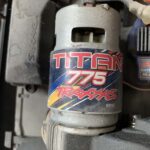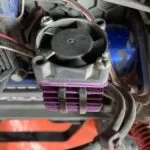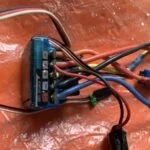How Hot Should a Brushed RC Motor Get (Avoid Damage)

If it seems that your brushed motor is running a bit too hot, it’s helpful to know what is actually considered to be too hot.
You may not have the proper knowledge to know what temperature is safe or dangerous for your brushed motor to run at, but today, we’ll catch you up to speed.
How Hot Should a Brushed Motor Get
Many of us get a little paranoid when we notice that our brushed motor is getting a bit too toasty.
This is completely understandable, as nobody wants their brand new motor to get burned right out of the box.
Brushed motors should run at temps of 180F – 220F. However, these temps should not be exceeded, and you should not let it run at max temperatures for too long.
Why Brushed Motors Get Hot
With brushed motors, they tend to get much hotter than brushless motors.
Why is that?
Well…
Brushed motors are named after the copper brushes that are placed against a conductive ring (the commutator ring), and provide the motor’s electromagnets with the energy they need to activate the magnetic poles and enable the motor to run.
As the motor runs, the brushes create friction with the rapidly rotating commutator ring, which generates heat and leads to greater wear and tear than expected.
Also, if you run your brushed motor too hard, it will get much hotter than it normally should. One of the common environmental factors that can cause your brushed motor to run harder than usual is running your RC car on grass. The reason this happens is due to the extra resistance that the grass provides.
Furthermore, if there isn’t sufficient space in your RC car’s body for your brushed motor, the heat generated by your motor can be trapped in a tight space, leading to the gradual decline of your brushed motor’s performance.
The Ideal Temp For A Brushed Motor To Run
When you’re running your brushed motor, you’re going to want to keep it cool. However, how cool are you supposed to keep it?
In other words, what is the ideal temp?
For brushed motors, 150F is a good temperature. Keep in mind that exceeding this temperature for too long will result in you burning out your motor faster.
How Hot Is Too Hot For A Brushed Motor
When running your brushed motor, flying too close to the sun can be a dangerous endeavor.
How hot is too hot, exactly?
Exceeding 220F is not a great idea, as this will only result in the quicker degradation of your brushed motor.
What Can Happen When A Brushed Motor Overheats
Sometimes, it helps to know the consequences of the mistreatment of your brushed motor. Perhaps it will keep you more focused on ensuring the longevity of your hardware.
When a brushed motor overheats, the electromagnets begin to lose their magnetism.
The electromagnets are instrumental in providing the motor with the armature’s rotation, meaning that if the electromagnets no longer work, then neither does your motor.
How To Know If Your Brushed Motor Is Overheating
In order to avoid completely burning out your brushed motor, knowing the signs of an overheating motor is essential.
The biggest telltale sign of an overheating motor is smelling something burning. If you smell something like fire, hot metal, or like something is on fire, then stop running your motor immediately.
Another way to tell if your brushed motor is overheating is to observe the performance. If your RC model is now performing poorly, when just the day before it was performing very well, you may have damaged your brushed motor by allowing it to overheat from overuse.
Keep Your Brushed Motor Cool
To help ensure your brushed motor’s longevity, it does wonders to maintain the cooling of your motor throughout its lifetime.
There are many ways to keep a brushed motor cool, but some of them run the risk of destroying the hardware you’ve bought, so we’re going to cover more safe and beginner-friendly methods.
One of the most popular and the safest method of cooling a brushed motor is to add an external fan.
The fan will blow air into the ventilation holes of the can (the body of the motor) and cool down your brushed motor.
Buying and attaching an external heat sink (an object that absorbs the heat from the motor) can greatly reduce the risk of overheating. Just like with the external fan, you can buy heat sinks on many different sites on the web.
If your motor’s can is lacking sufficient ventilation, carefully creating extra perforations in the body can help your brushed motor cool down, but remember to approach this method with extra care.
Conclusion
The condition of your brushed motor should be one of your top priorities when maintaining your RC car.
There are a multitude of ways to keep your brushed motor cool, and before you think that some of the previously mentioned methods might be too expensive to pursue, solutions like buying and attaching an external heat sink are actually very affordable (about 10$).
Also, making space for your brushed motor in the body of your RC car is usually free, while it may prove to be a bit of a pain to do for some of you.
In summary, what have we learned today?
We’ve learned that managing the heat generation of your brushed RC motor is essential to ensuring that it can maintain top performance and longevity.
Your Brushed RC motor will naturally generate plenty of extra heat due to the nature of how brushed motors operate, so shelling out those extra few bucks is well worth it to keep your motor in good condition.
Lastly, we’ve learned about the importance of knowing how the internal components of your RC model work, as retaining such knowledge can save you time and money in the future.





